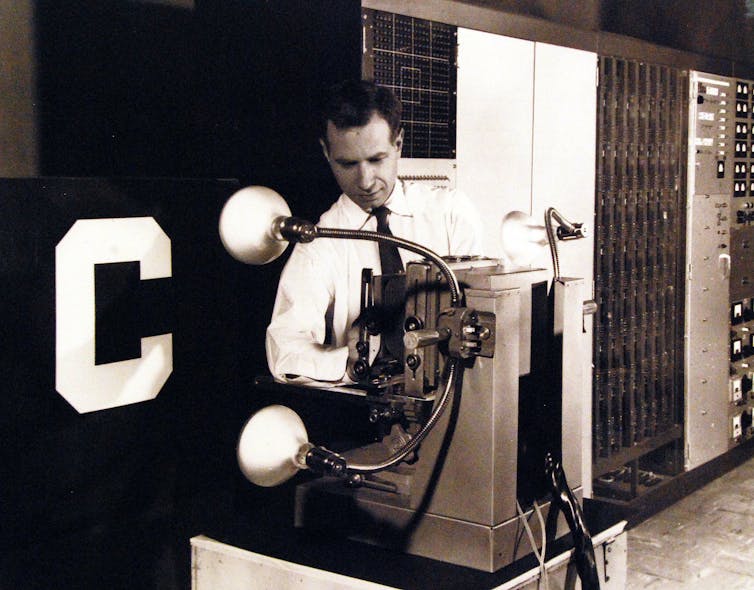[Source: @sliceofmallow]
Uncle Ben: Origins – A Spiderman Story (Parody Trailer)
Have you ever wondered about the man behind the man in the mask? Of course you haven’t. But what other option does Marvel have for their next big Hollywood movie? Check out the origin story of all origin stories, and learn about the man that gave us more Spiderman movies than you could have ever dreamed of.
We’ve been here before: AI promised humanlike machines – in 1958

Danielle Williams, Arts & Sciences at Washington University in St. Louis
A roomsize computer equipped with a new type of circuitry, the Perceptron, was introduced to the world in 1958 in a brief news story buried deep in The New York Times. The story cited the U.S. Navy as saying that the Perceptron would lead to machines that “will be able to walk, talk, see, write, reproduce itself and be conscious of its existence.”
More than six decades later, similar claims are being made about current artificial intelligence. So, what’s changed in the intervening years? In some ways, not much.
The field of artificial intelligence has been running through a boom-and-bust cycle since its early days. Now, as the field is in yet another boom, many proponents of the technology seem to have forgotten the failures of the past – and the reasons for them. While optimism drives progress, it’s worth paying attention to the history.
The Perceptron, invented by Frank Rosenblatt, arguably laid the foundations for AI. The electronic analog computer was a learning machine designed to predict whether an image belonged in one of two categories. This revolutionary machine was filled with wires that physically connected different components together. Modern day artificial neural networks that underpin familiar AI like ChatGPT and DALL-E are software versions of the Perceptron, except with substantially more layers, nodes and connections.
Much like modern-day machine learning, if the Perceptron returned the wrong answer, it would alter its connections so that it could make a better prediction of what comes next the next time around. Familiar modern AI systems work in much the same way. Using a prediction-based format, large language models, or LLMs, are able to produce impressive long-form text-based responses and associate images with text to produce new images based on prompts. These systems get better and better as they interact more with users.

AI boom and bust
In the decade or so after Rosenblatt unveiled the Mark I Perceptron, experts like Marvin Minsky claimed that the world would “have a machine with the general intelligence of an average human being” by the mid- to late-1970s. But despite some success, humanlike intelligence was nowhere to be found.
It quickly became apparent that the AI systems knew nothing about their subject matter. Without the appropriate background and contextual knowledge, it’s nearly impossible to accurately resolve ambiguities present in everyday language – a task humans perform effortlessly. The first AI “winter,” or period of disillusionment, hit in 1974 following the perceived failure of the Perceptron.
However, by 1980, AI was back in business, and the first official AI boom was in full swing. There were new expert systems, AIs designed to solve problems in specific areas of knowledge, that could identify objects and diagnose diseases from observable data. There were programs that could make complex inferences from simple stories, the first driverless car was ready to hit the road, and robots that could read and play music were playing for live audiences.
But it wasn’t long before the same problems stifled excitement once again. In 1987, the second AI winter hit. Expert systems were failing because they couldn’t handle novel information.
The 1990s changed the way experts approached problems in AI. Although the eventual thaw of the second winter didn’t lead to an official boom, AI underwent substantial changes. Researchers were tackling the problem of knowledge acquisition with data-driven approaches to machine learning that changed how AI acquired knowledge.
This time also marked a return to the neural-network-style perceptron, but this version was far more complex, dynamic and, most importantly, digital. The return to the neural network, along with the invention of the web browser and an increase in computing power, made it easier to collect images, mine for data and distribute datasets for machine learning tasks.
Familiar refrains
Fast forward to today and confidence in AI progress has begun once again to echo promises made nearly 60 years ago. The term “artificial general intelligence” is used to describe the activities of LLMs like those powering AI chatbots like ChatGPT. Artificial general intelligence, or AGI, describes a machine that has intelligence equal to humans, meaning the machine would be self-aware, able to solve problems, learn, plan for the future and possibly be conscious.
Just as Rosenblatt thought his Perceptron was a foundation for a conscious, humanlike machine, so do some contemporary AI theorists about today’s artificial neural networks. In 2023, Microsoft published a paper saying that “GPT-4’s performance is strikingly close to human-level performance.”

But before claiming that LLMs are exhibiting human-level intelligence, it might help to reflect on the cyclical nature of AI progress. Many of the same problems that haunted earlier iterations of AI are still present today. The difference is how those problems manifest.
For example, the knowledge problem persists to this day. ChatGPT continually struggles to respond to idioms, metaphors, rhetorical questions and sarcasm – unique forms of language that go beyond grammatical connections and instead require inferring the meaning of the words based on context.
Artificial neural networks can, with impressive accuracy, pick out objects in complex scenes. But give an AI a picture of a school bus lying on its side and it will very confidently say it’s a snowplow 97% of the time.
Lessons to heed
In fact, it turns out that AI is quite easy to fool in ways that humans would immediately identify. I think it’s a consideration worth taking seriously in light of how things have gone in the past.
The AI of today looks quite different than AI once did, but the problems of the past remain. As the saying goes: History may not repeat itself, but it often rhymes.
Danielle Williams, Postdoctoral Fellow in Philosophy of Science, Arts & Sciences at Washington University in St. Louis
This article is republished from The Conversation under a Creative Commons license. Read the original article.
Today’s Hottest Deals: SAMSUNG Galaxy Tab A9+, Sony Noise Canceling Wireless Headphones, SAMSUNG 49″ Super Ultrawide Monitor, Headway Premium, and MORE!
For today’s edition of “Deal of the Day,” here are some of the best deals we stumbled on while browsing the web this morning! Please note that Geeks are Sexy might get a small commission from qualifying purchases done through our posts. As an Amazon Associate, I earn from qualifying purchases.
–SAMSUNG Galaxy Tab A9+ 11” 64GB Android Tablet (Newly Released!) – $219.99 $189.99
–Sony WH-CH720N Noise Canceling Wireless Headphones – $149.99 $105.98
–Headway Premium: Lifetime Subscription – World’s Best Ideas in a Nutshell! Get 15-Min Summaries of the Best Books (Over 1500!) Based on Your Goals & Needs – $299.95 $49.97
–Soundcore Anker Motion Boom Waterproof Bluetooth Speaker with Titanium Drivers, BassUp Technology, IPX7, 24H Playtime, App, Built-in Handle – $109.99 $74.99
–SAMSUNG 49″ S95UA Super Ultrawide Dual QHD Monitor – $1,199.99 $707.91
–Avatar: The Last Airbender: The Official Cookbook: Recipes from the Four Nations – $24.99 $14.16
–16” Appa Pillow Pets / Stuffed Animal (From Avatar The Last Airbender) – $34.99 $23.99
–Funko Big Boss Strategy Board Game for 2-6 Players – $34.99 $10.86
–LEGO Icons Orchid Artificial Plant Building Set – $49.99 $40.98
–Microsoft Office Professional Plus 2019 for Windows – $229.00 $29.97
Get Ready to Roll: New DISCWORLD Tabletop RPG Announced!
Exciting news for Discworld fans and tabletop enthusiasts alike! Modiphius Entertainment has just announced their acquisition of the license to produce games based on Terry Pratchett’s beloved Discworld series. The first offering from this partnership will be a tabletop roleplaying game set in the city of Ankh-Morpork and the wider Disc, with plans for a Kickstarter campaign slated for late 2024.
This announcement marks a significant moment for Discworld tabletop gaming, with the last RPG based on the series released way back in 1998. Modiphius aims to capture the essence of Pratchett’s unique world, promising games that “honour the humour, satire, and darkly entertaining fantasy series” that has enchanted readers for decades.
For those unfamiliar, Discworld is a sprawling fantasy universe created by Terry Pratchett, encompassing over 40 novels that span various genres and themes. From traditional fantasy tropes to witty crime procedurals, Pratchett’s world is as diverse as it is imaginative. With the 40th anniversary of the first Discworld book, “The Color of Magic,” celebrated just last year, the timing couldn’t be more perfect for this tabletop renaissance.
Chris Birch, founder and chief creative officer of Modiphius, expressed his enthusiasm for the project, recognizing the special place Ankh-Morpork holds in the hearts of fans. Interestingly, Pratchett himself was an avid tabletop roleplaying enthusiast, drawing inspiration from his own gaming experiences for many of the characters and ideas within his novels.
But Modiphius isn’t stopping there—they’re inviting the Discworld community to help shape the future of these games through a survey, ensuring that the spirit of Discworld remains true in every aspect of gameplay. So whether you’re a seasoned tabletop adventurer or a die-hard Discworld aficionado, there’s plenty to look forward to in the world of Discworld tabletop gaming. Keep your eyes peeled for updates and get ready to embark on new adventures in Ankh-Morpork and beyond!
[Image credit: Modiphius, Via CB]
Please note that Geeks are Sexy might get a small commission from qualifying purchases done through our posts. As an Amazon Associate, I earn from qualifying purchases.
Island Survival [Comic]
[Source: @inkyrickshaw]
Death and The Cat [Comic]
[Source: @deadthchan]
King Kong (Abridged) [Comic]
New Epic Rap Battle of History: Godzilla vs King Kong!
Get ready to witness the clash of the titans in the latest Epic Rap Battles of History! In one corner, we have the unstoppable force of nature, Godzilla, towering over all with his atomic breath and ferocious might, and in the other corner, King Kong, swinging into battle with primal strength and agility. Who will reign supreme? Tune in to witness the lyrical mayhem as Godzilla and King Kong spit fire and drop beats in the ultimate clash of monstrous proportions!
[ERB]
Today’s Hottest Deals: D&D The Yawning Portal Strategy Board Game, The Toxic Avenger 4K Collection Tox Set, Soundcore Anker Life Q20 Hybrid ANC Headphones, GoPro HERO11, and More!
For today’s edition of “Deal of the Day,” here are some of the best deals we stumbled on while browsing the web this morning! Please note that Geeks are Sexy might get a small commission from qualifying purchases done through our posts. As an Amazon Associate, I earn from qualifying purchases.
–Dungeons & Dragons: The Yawning Portal D&D Strategy Board Game for 1-4 Players – $55.99 $23.90
–The Toxic Avenger Collection Tox Set 4K Ultra HD (8-Disc Collector’s Edition Box Set – 4K Ultra HD + Blu-ray, Special Edition) – $139.95 $84.00
–Soundcore Anker Life Q20 Hybrid Active Noise Cancelling Headphones With 60H Playtime – $59.99 $39.98
–GoPro HERO11 Black Waterproof Action Camera with 5.3K60 Ultra HD Video, 27MP Photos, 1/1.9″ Image Sensor, Live Streaming, Webcam, Stabilization – $299.99 $254.99
–Dell 27-Inch 4K UHD (3840 x 2160) IPS Ultra-Thin Bezel Monitor – $299.99 $229.99
–Save Up to 40% Off on Samsung Computer Monitors
–8Bitdo Ultimate 2.4g Wireless Controller with Charging Dock for Windows, Android & Raspberry Pi – $49.99 $37.99
–Anycubic Kobra Plus Large 3D Printer with Auto Leveling (Build Volume 13.8″ x 11.8″ x 11.8″) – $428.99 $283.99
–KMC 6-Outlet Surge Protector Power Strip 2-Pack – $19.99 $12.23 (Clip Coupon at the Link!)
–LEGO Sunflowers Building Kit – $14.99 $12.97
–Microsoft Office Professional Plus 2019 for Windows – $229.00 $29.97







